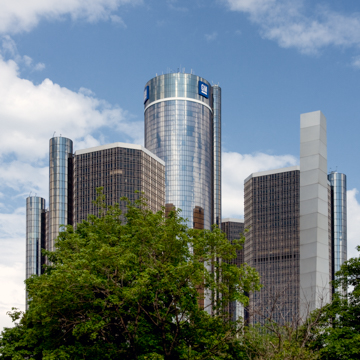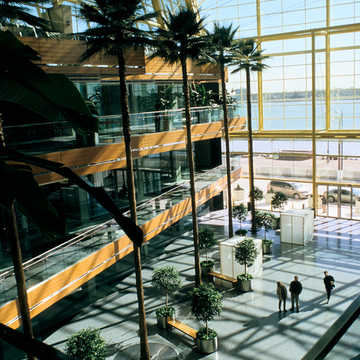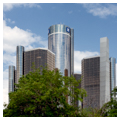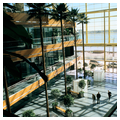You are here
GM Renaissance Center
In 2003, seven years after acquiring the RenCen in 1996 for $75 million, General Motors Corporation completed a $500 million renovation of the office towers and the 1,298-room Marriott Hotel. The berms that hid the front doors and isolated the building from the city were removed and a new glass and stainless steel entrance pavilion and plaza created. A promenade along the Detroit River invites visitors to enjoy the riverfront. Inside, the interior circulation ring improved movement through the building, and the Wintergarden, a delightful glass atrium addition that rises five stories on the riverfront, beckons to shoppers and workers.
The $350 million hotel, office, and retail megastructure was planned by Henry Ford II, promoted by the Ford Land Development, and financed by five institutions. Designed by noted Atlanta architect Portman, the seventy-three-story cylindrical hotel and four thirty-nine-story octagonal office towers rise from a concrete podium containing shops, theaters, and restaurants. The collaborators intended the RenCen to demonstrate a dramatic renewal for downtown Detroit after the racial disturbances of 1967. But to many Detroiters the concrete and tinted glass building with bridges and atria (a Portman insignia) seemed to isolate itself from the city rather than to demonstrate and represent a renaissance of cooperation. Today the RenCen reconnects with the city and the riverfront.
Writing Credits
If SAH Archipedia has been useful to you, please consider supporting it.
SAH Archipedia tells the story of the United States through its buildings, landscapes, and cities. This freely available resource empowers the public with authoritative knowledge that deepens their understanding and appreciation of the built environment. But the Society of Architectural Historians, which created SAH Archipedia with University of Virginia Press, needs your support to maintain the high-caliber research, writing, photography, cartography, editing, design, and programming that make SAH Archipedia a trusted online resource available to all who value the history of place, heritage tourism, and learning.





